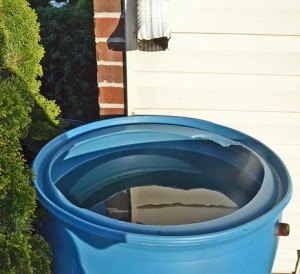It’s not clear that a barrel of monkeys is much fun.
Nor maybe a barrel of rain water either.
But collecting rain water in a barrel is quite useful.
Peter Holden of the Loudoun Soil and Water Conservation District came out to Lovettsville last Wednesday to the Quarter Branch Barn, in partnership with the Town, to help the local folk to build or buy barrels to collect rain water.
Some may think that there’s so much water, that it’s quaint to collect rain water in a barrel.
Although 70% of the earth is covered in water, less than one half of one percent of all that water is fresh, available and drinkable.
That’s not a lot worldwide, particularly when some is wasted, compromised by pollution, and not where it’s needed.
It’s startling that one fifth of all the world’s fresh water is found in Lake Baikal in Siberia.
We should be concerned because water is right up there after air for our survival.
The world record for holding one’s breath is 22 minutes for a trained free diver, Stig Severinsen (after Stig hyperventilated to rid himself of carbon dioxide). But many can hardly hold their breath for even a minute.
As for living without water, three to five days is about right although it depends on your physical condition.
Many presume that water is free. But mostly it costs to treat and recycle it. Town folk pay water taxes. Away from sources of public water, homeowners and renters maintain well and septic systems and filters and pumps.
Harvesting falling rain water in a barrel lightens the burden on public and private water sources.
Peter said, “Rain barrels are an old technology that has come back into style as people focus on conserving our resources and minimizing the impact on the environment.”
“Rain barrels can be as simple as a plastic or metal barrel,” Peter said, “placed under an existing downspout.”
“Every time you use collected rain water,” Peter said, “you are replacing chemically treated public water, and are saving money.”
The Town of Lovettsville partnered with Pete’s effort and offered a $20 utility bill credit for all Town water customers who made or purchased a barrel (one credit per household).
Mayor Bob Zoldos said, “We did this because this is another way for the Town to conserve water.”
Pete added, “This rain barrel system can be especially important in periods of drought when there are restrictions on public water use. During these times, you can continue to water plants and gardens, wash your car, and use your rain barrel water for other uses that are restricted during a drought. If your water is supplied by a well on your property, a rain barrel can limit stress on the well for outdoors uses. It can also supply a source of water to flush toilets during power outages when well pumps are inoperable.”
Your roof is the collection area for rain water.
Pete said, “A downspout which services a 300 square feet of roof will fill a 55 gallon rain barrel during a 1/3 inch rain storm.”
The more rain, the larger the roof area, the more barrels linked to one another, the more rain water you can collect.
You need a clear gutter, perhaps a filter, a downspout about 5 to 6 inches wide, a barrel near the down spout nearest your garden, standing uphill (if at all possible), so you have water pressure by gravity; otherwise, there are always buckets.
Pete says you must place the spigot high enough on the barrel so that you can get the bucket under the spigot.
If you missed Pete’s class, you can ask those who attended what they learned, or you can refer to Pete’s on-line brochure.
Pete said, “When you do this, you’re not just getting free water, and taking care of your own needs, you’re also protecting the Chesapeake Bay and its watersheds.


